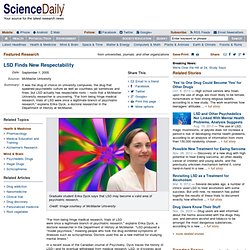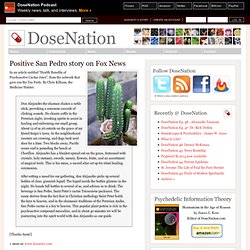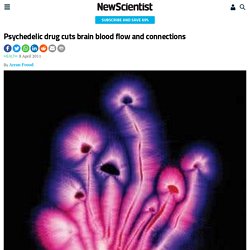

LSD Finds New Respectability. "Far from being fringe medical research, trials of LSD were once a legitimate branch of psychiatric research," explains Erika Dyck, a doctoral researcher in the Department of History at McMaster.

"LSD produced a "model psychosis," meaning people who took the drug exhibited symptoms of illnesses such as schizophrenia. Doctors used this as a new method for studying mental illness. " In a recent issue of the Canadian Journal of Psychiatry, Dyck traces the history of LSD—and its eventual withdrawal from medical research. LSD, or d-lysergic acid diethylamide, first appeared in scientific literature in 1943. For nearly a decade, it gave psychiatrists insight into the experi-ences of schizophrenic patients and showed potential as a cure for alcoholism. Now, therapeutic uses of psychedelic drugs are resurfacing. This makes Dyck optimistic that LSD may become a valid area of research again. The paper is available online at www.cpa-apc.org/Publications/Archives/CJP/2005/june/InRevDyck.asp. The Psychedelic Experience. "If you started in the wrong way," I said in answer to the investigator's questions, "everything that happened would be a proof of the conspiracy against you.

It would all be self-validating. You couldn't draw a breath without knowing it was part of the plot. " "So you think you know where madness lies? " My answer was a convinced and heartfelt, "Yes. " "And you couldn't control it? " Slideshow: Scientists Analyze Drawings by an Acid-Tripping Artist. Credit: sxc.hu user FOTOMO The following nine drawings were made a half century ago by an artist under the influence of LSD, or acid, during an experiment designed to investigate the psychedelic drug's effects .

The unnamed artist was given two 50-microgram doses of LSD, one 65 minutes after the other, and had access to an activity box full of crayons and pencils. The subject of his art was the assisting doctor who administered the drug. Though records of the identity of the principal researcher have been lost, it was probably a University of California-Irvine psychiatrist, Oscar Janiger. Janiger, known for his LSD research, died in 2001. "I believe the pictures are from an experiment conducted by the psychiatrist Oscar Janiger starting in 1954 and continuing for seven years, during which time he gave LSD to over 100 professional artists and measured its effects on their artistic output and creative ability.
Psychoactive Vaults : "Using Psychedelics Wisely" by Myron Stolaroff. My wife Jean and I had driven several miles up the mountain to an elevation of 6000 feet a few miles south of Mount Whitney in California.

We were about to meet Franklin Merrell-Wolff, author of the book Pathways through to Space, an impressively articulate and detailed description of a person entering a state of enlightenment and savoring it over several months. When we were ushered into his private office, we found ourselves before an outstanding personage who radiated a marvelous glow. When we had talked for a few minutes and I felt sufficiently at home, I spoke of our research work, telling him that we had spent three and a half years administering LSD, sometimes in conjunction with mescaline, to 350 research subjects and had published our findings in medical journals. "My oh my! " he said, looking at us with consternation. We admitted that we had. There is no question that psychedelic substances are remarkable graces.
MOTIVATION This is extremely important. Blumenthal,Michael. 1992_hermle_6150_1.pdf (application/pdf Object) Positive San Pedro story on Fox News. In an article entitled "Health Benefits of Psychoactive Cactus Juice", from the network that gave you the Tea Party.

By Chris Kilham, the Medicine Hunter. Don Alejandro the shaman shakes a rattle stick, provoking a sensuous cascade of clicking sounds. He chants softly in the Peruvian night, invoking spirits to assist in healing and enlivening our small group. About 12 of us sit outside on the grass of my friend Sergio’s lawn. In the neighborhood roosters are crowing, and dogs bark next door for a time. [Thanks Sami!] Psychedelic drug cuts brain blood flow and connections - health - 08 April 2011. By Arran Frood Psychedelic drug users throughout the ages have described their experiences as mind-expanding.

They might be surprised, therefore, to hear that psilocybin – the active ingredient in magic mushrooms – actually decreases blood flow as well as connectivity between important areas of the brain that control perception and cognition. The same areas can be overactive in people who suffer from depression, making the drug a potential treatment option for the condition. The study is the first time that psilocybin’s effects have been measured with fMRI, and the first experiment involving a hallucinogenic drug and human participants in the UK for decades. Robin Carhart-Harris at Imperial College London and colleagues recruited 30 volunteers who agreed to be injected with psilocybin and have their brain scanned using two types of fMRI. Low flow Less blood flow was seen in the brain regions known as the thalamus, the posterior cingulate and the medial prefrontal cortex.
Mood swing.